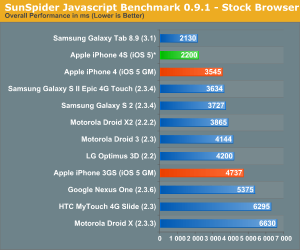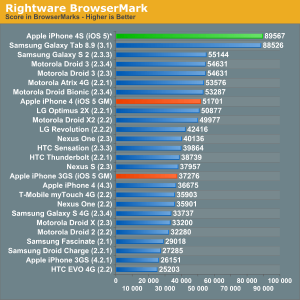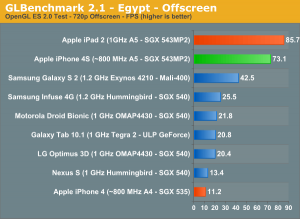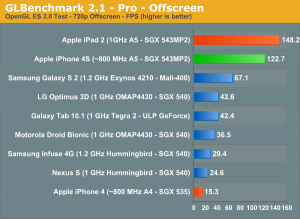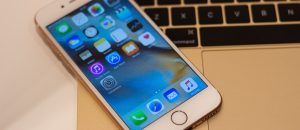Last week Apple revealed the iPhone 4S. However, typical Apple, they didn’t reveal too many details about its processing power; and, well, you can’t blame them: Most consumers don’t care what is inside as long as the user experience is to their liking. Geeks, on the other hand, very much do care about these silly things we call benchmarks. And it didn’t take long for some geek with geeky stuff to benchmark the iPhone 4S and let the whole world see.
iPhone 4S vs. The World
CPU Benchmarks
GPU Benchmarks
Discussion
Well, well, well; what do we have here. If the iPhone 4S sucks so bad then why did it wipe the floor with the competition? First of all, to cover my own ass, let me state I never complained about the processing power of the iPhone 4S. In fact I stated the CPU + GPU combination on the iPhone 4S will provide, and I quote, “excellent performance”. That said, though, it is significant that iPhone 4S is walking circles around the competition. Why is this? Let’s discuss this one step at a time.
First let’s talk CPU. iPhone 4S has a dual-core Apple A5 (both cores are clocked at 800 mhz, probably to improve battery life versus a 1,000 mhz clock) running on iOS 5. iOS 5 is optimized to fully use the power of dual-core processors; Android 2.3.x (Gingerbread) is not fully optimized for dual-core processors. This is why you see iPhone 4S score almost 2x as well as Android devices that also have dual-core processors (most of the Android processors are clocked at 1000 mhz and all Android phones are running Gingerbread or lower). If you don’t believe me take a look at the Samsung Galaxy Tab 8.9.
The Samsung Galaxy Tab 8.9 runs on Android 3.1, otherwise known as Honeycomb. (This is the Android version specifically for tablets.) The Galaxy Tab 8.9, which sports a Tegra 2 [dual-core processor at 1000 mhz], scores just as well as the iPhone 4S. This is because Honeycomb has been optimized for dual-core processors. Android Ice Cream Sandwich, which is set to be released in “October or November” of this year, is expected to bring that same dual-core optimization to Android phones. Assuming the phones mentioned in the above benchmarks get Ice Cream Sandwich in a timely manner (updates, unfortunately, have been an issue with Android devices in the past, with the exception of the Nexus line), that will (should) bridge the gap that you see between iPhone 4S and Android phones. In other words, Apple A5 isn’t anything to write home about verses other dual-core processors such as Nvidia’s Tegra 2, Samsung’s Exynos, Qualcomm’s dual-core Snapdragons, etc.
The GPU on the iPhone 4S, however, is a different story. Tucked away inside its shiny exterior, the iPhone 4S has a PowerVR SGX 543MP2. (This is the same GPU found in iPad 2.) The SGX 543MP2 is the most powerful GPU in use on the mobile device market right now, hands down. So, it comes as no surprise that GPU benchmarks show iPhone 4S comfortably ahead of the competition, most notably the much-acclaimed Samsung Galaxy S II. This lead in graphics processing power is not primarily due to software; unlike in the case of the CPU, the hardware here is just superior to the competition. It is really as simple as that. It is worth noting, though, the GPU tests were ran at a 1280 x 720 resolution. At lower resolutions, which is what most phones currently run at, the FPS is capped at ~60 fps via software restrictions. So while theoretically SGX 543MP2 is the most powerful, in real-world application in smartphones, such as video games or watching videos, there most likely won’t be a noticeable difference between the SGX 543MP2 and the competition. I put emphasis on most likely because there is no reliable way to test “real-world difference” when software is capping the frames per second; thus I can only state conjecture, not fact.
(As a side-but-still-on-topic note, when I found out the Galaxy S II does not use a PowerVR chip for its GPU, I was very, very, very disappointed. PowerVR makes the most powerful GPUs. Samsung Galaxy S [first generation] used a PowerVR chip, specifically SGX 540, which gave it superior graphics processing, although I am sure many people will argue that graphics processing power still has not been fully tapped to this day. This time around, however, for whatever reason, Samsung went with Mali-400, an ARM GPU, instead of another PowerVR chip. For what it is worth, though, when the Galaxy S II came out back in May, the Mali-400 was the strongest GPU in phones at that time.)
Should I just Buy an iPhone?
No. Yes. No. Yes. Wait, erm. Ahhhhhhhhhhhhhhhhhh… Breathe Ashraf, breathe.
At the beginning of this article I stated most consumers don’t care about the internals as long as the user experience is satisfactory. And that really is the answer to the question of “should I buy an iPhone [4S] or an Android [or Windows] device”. For most of us, even us *gasp* geeks, what is inside isn’t as important as what we see and use everyday. That is to say, as long as the internals can handle what we throw at them – should that be web browsing, checking email, watching videos, playing games, whatever – the CPU/GPU/memory/etc. isn’t as important as stuff like the software, the screen, the feel of the phone, etc. In other words, user experience trumps hardware any day of the week. Whether it be an iPhone or a competitor (Android, Windows Phone, etc.), one should look for superior user experience verses only paying attention to the chips inside.
In that regard, iPhone has an upper hand over the competition. Although some people may want you to think so, I am not saying iPhone has the best user experience available. Rather, iPhone’s advantage is that it has a consistently excellent user experience. When you buy an iPhone you know what you are going to get. On the other hand, because there are multiple different manufacturers and each manufacturer can tweak their devices as they see fit, Android (and Windows Phone, to an extent) devices have a variable user experience; consumers don’t always know what they will get and sometimes their expectations are not fulfilled. That doesn’t mean Android devices are inferior to the iPhone. There are some Android devices that are brilliant. For example, Samsung Galaxy S II is a stunner; Motorola Photon is terrific; Nexus S is smoother than a baby’s butt. Then there are other devices that make me want to cry, such as the LG G2x which has been plagued with faulty hardware and software bugs since its release. When it comes to Android you need to do a little bit of research on the device and the manufacturer prior to purchasing to ensure you aren’t jumping onto a sinking ship; with an iPhone, you don’t — an iPhone is an iPhone and you will get the iPhone experience (assuming, of course, Apple doesn’t make a blunder).
For what it is worth, in my opinion the Samsung Galaxy S II is the best Android device on the market right now. The Galaxy S II is fast (little to no lag), has an absolutely stunning Super AMOLED Plus display (4.3-4.5 inches, depending on which version of the phone you get), has “4G” connectivity (depending on which version of the phone you get and where you live), and has excellent battery life. Although its graphics processor is technically less powerful than the iPhone 4S’ and Android Gingerbread isn’t fully optimized for dual-core processors, the Galaxy S II is able to handle whatever you throw at it; and while some people won’t admit it, watching videos and/or playing games on a 4.3 inch screen is far more fun than on a 3.5 incher; especially since the Super AMOLED Plus display is what many critics consider to be the best on the market right now; superior to even Retina. (It took Samsung two tries to do it but they eventually beat Apple’s much-loved Retina.) I do understand, however, that for some people 4.3+ inches may be too big. For these people 3.5 inches may be more preferable and the iPhone 4S offers that. No phone is “perfect”; each phone has pros and cons, iPhone 4S and Galaxy S II included.
That said, as a rule of thumb, I tell people if they want Android at its best, go with the Nexus line of devices. The Nexus line (Nexus One, Nexus S, and the soon-to-be-released Galaxy Nexus/Nexus Prime) phones are manufactured by the big names (Nexus One was HTC, Nexus S was Samsung, and Galaxy Nexus/Nexus Prime is going to be Samsung) but the software is maintained directly by Google. This means a superior – and consistent – user experience thanks to vanilla Android (i.e. no custom manufacturer changes/skins), little to no bloatware (typically just Google’s own apps, which tend to be more useful than useless), and fast updates to new Android releases. Nexus S was (is) a success because it combines Samsung’s great hardware (i.e. the stuff in the original Galaxy S phones) with Google’s great software. The Galaxy Nexus/Nexus Prime is set to be announced this month and probably will be available by November. (It was going to be announced on October 11 but Samsung pushed the release date back in “respect to Steve Jobs”.) Above I said the Samsung Galaxy S II is the best Android device on the market right now. The Galaxy Nexus/Nexus Prime will be the best Android device on the market once it is revealed. Rumor has it will be an improved Galaxy S II (4.65 inch Super AMOLED Plus display, 1.5 ghz dual-core Exynos, dual-core PowerVR SGX 543MP2 [same GPU as iPhone 4S], larger battery, and LTE support for networks with LTE) with vanilla Android (Ice Cream Sandwich). Although I feel a 4.65 inch screen is too big, I think I am drooling already. Someone want to buy me one? =D
Anyway, to get back to the question on hand, I can’t tell you what phone is best for you. You have to decide what you prefer and what works best for you. Do you want to play it safe? Go iPhone 4S. Do you prefer choice and are willing to do a little research before buying? Look at Android handsets. Want something different? Windows Phone 7 may be for you. Whatever you decide, all three platforms (although Windows Phone 7 is still a little behind iOS and Android) provide consumers with an excellent experience if consumers make informed, educated decisions… as opposed to grabbing the first thing your local salesperson throws at you.
Feel free to discuss in comments below. I love flame wars.
[Benchmarks via AnandTech]

 Email article
Email article
